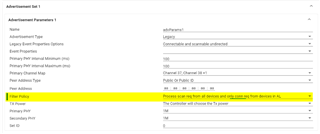Other Parts Discussed in Thread: SYSCONFIG
Tool/software:
I'm exploring ways to prevent the CC2340R5 from connecting to other centrals.
Several options found (not sure what is the best):
-
Direct advertising - tried to configure CC2340R5 syscfg to direct advertising and set my android BDADDR.
result: cc2340R5 is not visible in android phone scanning phase. -
Whitelist - can't find suitable example (different chip, old stacks with different API's, example found are for centrals not peripherals).
-
Accept List - can't find suitable example. (HCI API documentation suggest we can add remove items from the accept list).
if it helps, currently the CC2340R5 use Public Address mode. Bonding capabilities are "no display no input devices".
What of the solution above may fit our requirement?
if possible, please share link to relevant implementation/syscfg configuration examples.



